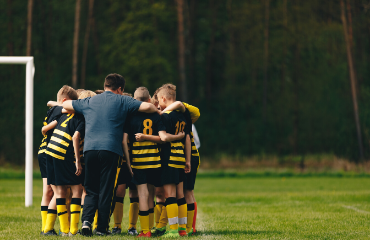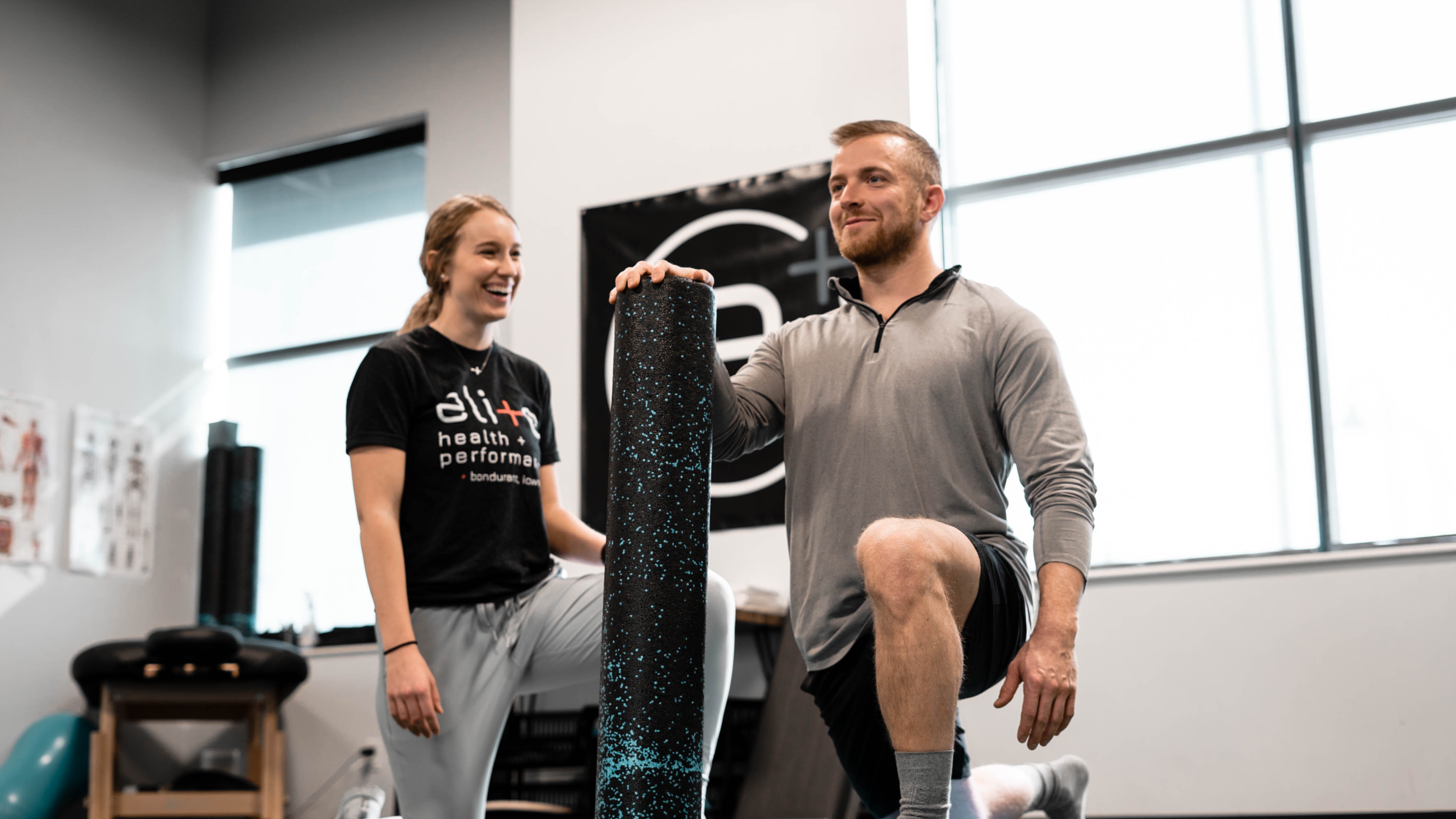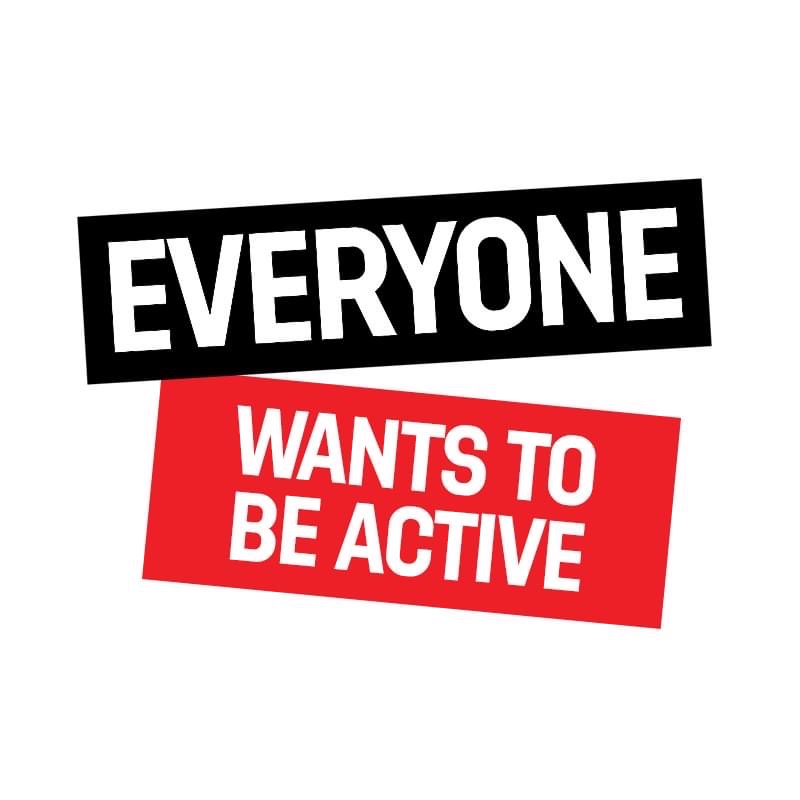Sports, Leisure and Physical Activity
Where do I fit in the Sport and Leisure world?
SPORTS, AND PHYSICAL ACTIVITY
Working in Sport and Physical Activity means keeping the population healthy and active not only physically but also mentally. You will be able to take your current passion or interest in sport and wellbeing and pass it on to people you meet whilst working in the sector.
WHERE DO I FIT IN THE SPORT AND PHYSICAL ACTIVITY WORLD?
From a young age, many people know they want to work in Sport and Physical Activity but are unsure of where they can fit in. There are hundreds of possible roads you can take, the one you go down will be largely related to your current interests.
Start to ask yourselves the following questions:
- What is/was my favourite part of P.E./Sport Studies?
- Do any of my other subjects/qualifications relate to Sport and Physical Activity in any way?
- What is my favourite Sport or Pastime?
- What roles are there in Sport and Physical Activity sector and how do they link to my interest? (Linked to 6 core industries here – CIMSPA - Adventure Sports)
- When I find out the roles best suited to me, can I get some work experience/volunteering at my current sports or community club(s)?
- What Further or Higher Education courses will best assist my career in Sport and Physical Activity? (Links to Apprenticeships and Foundation and BA Degrees)
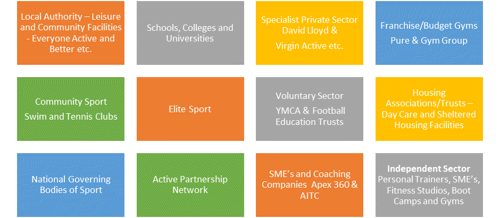
The Sport & Physical Activity Employer Landscape
From a young age, many people know they want to work in Sport and Leisure but are unsure of where they can fit in. There are hundreds of possible roads you can take, the one you go down will be largely related to your current interests.
Start to ask yourselves the following questions:
- What is/was my favourite part of P.E./Sport Studies?
- Do any of my other subjects/qualifications relate to Sport in any way?
- What is my favourite Sport?
- What roles are there in Sport and how do they link to my interest?
- When I find out the roles best suited to me, can I get some work experience/volunteering at my current sports club(s)?
- What Further or Higher Education courses will best assist my career in Sport?
GAINING WORK OR VOLUNTEERING EXPERIENCE IN SPORT AND PHYSICAL ACTIVITY SECTOR
Workforce Development - What are we trying to achieve?

The Chartered Institute for the Management of Sport and Physical Activity
CIMSPA is the professional development body for the UK’s sport and physical activity sector, committed to supporting, developing, and enabling professionals and organisations to succeed and, as a result, inspire our nation to become more active. Together CIMSPA and employers are developing a vibrant, UK-wide sport and physical activity sector, with the highest standards of service delivery.
Education and Training
CIMSPA provides an employer-led and quality-assured education and training system for the sport and physical activity sector. A fundamental part of CIMSPA’s work is the creation, development, and implementation of regulation, professional standards and apprenticeship Standards.
CIMSPA’s vision
Shaping a recognised, valued and inclusive sport and physical activity sector that everyone can be a part of. https://www.cimspa.co.uk/
CIMSPA Careers Guide for the Sport and Physical Activity Sector
CIMSPA has created a new ‘Careers Guide for the Sport and Physical Activity Sector’, the first definitive set of career advice and guidance for the sector. The guide is designed to help everyone in sport and physical activity realise their potential by showing clear routes into and through the sector.
With over 585,000 people currently working in sport and physical activity in the UK, this is a large, diverse and vibrant sector with a huge variety of career and professional development opportunities. CIMSPA’s goal is to help everyone understand and take advantage of these opportunities, supporting them to have long and satisfying careers.
The new careers guide breaks down the different industries and occupations that exist within sport and physical activity, including front line practitioner, management and senior leadership positions. The guide goes into detail on what the different roles entail, and the professional recognition needed for each of them. It also provides advice on how to access the right training and qualifications to meet those career goals.
CIMSPA helping to define the sport and physical activity sector workforce.
The sport and physical activity sector are made up of six core industries and occupations listed below:
- Exercise and Fitness
- Performance Sport
- Community Sport
- Leisure Operations
- Health and Wellbeing
- Adventure Sport

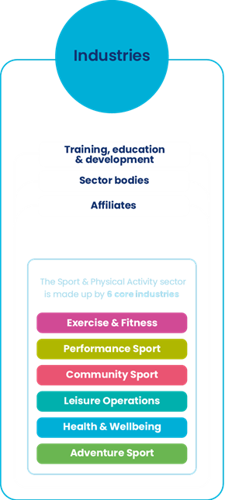
CAREERS PATHWAYS IN SCIENCE
JOB ROLES
Take a look at some job roles in the Sport & Physical Activity Sector – CIMSPA link
TRAINING COURSES
Here you can find all the short courses and qualifications relevant to the Sport & Physical Activity Sector. Browse courses that are quality assured by the Education and Skills Funding Agency.
APPRENTICESHIPS
Apprenticeships are one way to start a sport and physical activity career. Go to our HOP pages on Apprenticeships for more information on how to become an apprentice.
You can find out more detail on what each apprenticeship qualification involves through the Institute of Apprenticeships.
HIGHER EDUCATION
The Institute of Sport at the University of Hertfordshire offers you brand new laboratories and learning spaces, where you’ll use research technologies including pharmaceutical manufacturing equipment, cell culture facilities and aseptic suites.
Their courses span sports development and exercise science, sports business management, coaching and sports therapy. Find out more here.
Courses at the University of Hertfordshire have a long and successful reputation representing some of the newest and fastest-growing areas in sport and physical activity. Students will learn through practical work and develop the skills you need when you graduate. The state-of-the-art facilities that include a sports injury clinic, human physiology laboratory, 3D motion analysis laboratory, performance testing centre and the Hertfordshire Sports Village
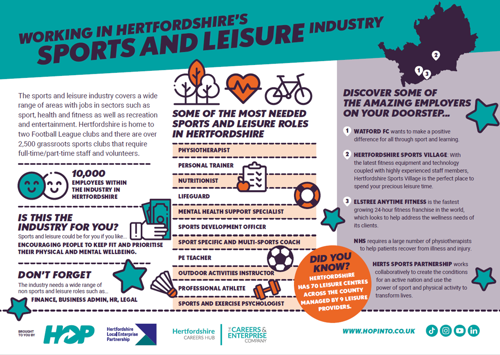
Employers in Hertfordshire in Sport and Leisure
There are:
- an estimated 2,500 Sports Clubs
- 5 Community Sport Networks (CSN) - identify local need and work together to attract funding to support the development of sports clubs, coaches and volunteers, promote the benefits of sport and physical activity and encourage greater participation in sporting opportunities.
- An estimated 100,000 Volunteers who assist with the running of clubs, events and charitable organisations
- An estimated 70 Leisure facilities across the county managed by 9 Leisure providers
- 50 Coaching Agencies which provide services to schools and clubs for holiday camps and extra-curricular activity
- 4 Professional Club Foundations - Saracens Maverick Netball, Stevenage FC Foundation, Watford FC CSE Trust and Saracens Sport Foundation
The 8 leisure providers are:
- Everyone Active
- Stevenage Leisure Limited
- Hertfordshire Sports Village
- UH Sport – HertSquad
- Better Leisure Centres
- Broxbourne Council Leisure
- Hertsmere – InspireALL
- One YMCA
Gaining work or volunteering experience in Sport
Knowing your employers and the path you may want to take is the first step in knowing where you can gain valuable work experience. You must be willing to ask local clubs, leisure centres and even the schools for potential roles, during weekends, half terms and Christmas and summer breaks.
Dependant on your career aspirations finding direct experience may be difficult. For example, if you wish to work in physiotherapy, sport science or sport psychology then experience will most likely come nearer the end of your studying, however, some transferrable roles may be to work alongside sports coaches or even shadow people in the role you intend to pursue.
A further option is to find an appropriate apprenticeship scheme; many organisations offer apprenticeships where you can learn on the job. Apprenticeships are available for Sports Coaching, Fitness Instructing, Activity Leadership and many more.
Making the most of your PE teacher or current Sports Instructor is a great way to find appropriate experience and apprenticeship schemes, as they will have the best understanding of sport and leisure in your local area.
Becoming a volunteer
One of the first steps you can take is to become a volunteer at a local Sports club or leisure centre; this can also involve helping with running local events. Using https://www.govolherts.org.uk/ you can register your interest as a volunteer and search the website for any opportunities suited to you. Clubs and organisations are always in need of volunteers.
Making a difference
Working in Sport and Leisure doesn’t always mean assisting people who are already fit and healthy. In fact, a large part of the sectors responsibility it to make sure Physical Activity is open to ALL. This includes those who wouldn’t normally be able to take part in Sport and Leisure such as:
- those with long term illnesses
- disabled people
- those suffering with mental health issues
- people who live in deprived areas
- older adults
There are 12.2 million disabled people in England, with 14.3% of the Hertfordshire population reporting that their day-to-day activities are limited by a disability or long-term illness. This filters into physical activity participation, as disabled adults are almost twice as likely as non-disabled people to be physically inactive (42.4% vs 22.6%).
Live Longer Better in Hertfordshire is a local collaborative activation of the national Live Longer Better campaign which seeks to enable our older adult population to lead longer happier and healthier lives through remaining physically, cognitively and socially active.,
Hayley Jarvis, Head of Physical Activity at Mind, said:
“We know that physical and mental health go hand in hand and it is now well-established that being more physically active can have real benefits to our mental health. Yet despite this, many people with mental health problems face barriers to getting active, ranging from fears about physical appearance or being intimidated by going to the gym, to finding it hard to get out of the house. The good news is that, by upskilling staff and volunteers across the sport and physical activity sector, we can begin to break down some of these barriers. We hope that the Regional Networks will help bring about real change in the sector that leads to more people with mental health problems feeling able to get more active.”
Becoming a more skilled Sports Coach/Leisure Instructor/Personal Trainer, how do I go about this?
Herts Sport Partnership have comprised a host of courses and workshops to aid existing coaches and inform those looking to enter the industry! Courses range from general training to Sport Specific training, tailoring to your needs. You can explore an updated directory of these course here.
To get answers to any further queries contact Herts Sports Partnership, who have extended knowledge of the Sport and Leisure sector. A member of the team may be able to push you in the right direction when moving forward with your career in Sport and Leisure.
Get in touch:
- Phone - 01707 284229
- E-mail – [email protected]
The National Careers Service is a useful website to explore different careers in Sports and Leisure.
You can also use the HOP careers directory to research different job roles, understand the main tasks and average salaries, learn about which qualifications you should consider studying and explore the current job and apprenticeship vacancies in Hertfordshire. A selection of roles are below, click further and search sports and leisure to find more roles.
How to become a Personal Trainer?
If you enjoy fitness and have a passion for helping other people achieve their goals, then Personal Training could be the career for you! A Personal Trainer usually works in a gym environment and is responsible for writing training programmes and delivering one-to-one fitness sessions for a range of clients. Sounds good right? Well yes, its certainly a rewarding career – however before you make the decision and take the plunge, there are numerous things to think about.
So, how to become a Personal Trainer? To answer this, we caught up with fitness education expert James Luscombe from Hertfordshire based Personal Trainer course provider Study Active to find out how!
What qualification do I need to be a Personal Trainer?
To be a Personal Trainer you will need to complete a Level 2 in Gym Instructing and Level 3 in Personal Training (some providers offer these as one big course). You may see lots of different variations out there but the important thing to remember is that any Gym or PT qualification that is worth its weight (excuse the pun!) in the fitness sector must be CIMSPA endorsed. This means that CIMSPA, who are the professional body of the Fitness sector have given the thumbs up to the content, which is very important – other wise it may not be recognised, meaning you could miss out on that dream career!
TIP: Beware of quick-fix cheap options – they are unlikely to be CIMSPA endorsed!
How can I study to be a Personal Trainer?
Good question! And this is an important thing to consider. Whilst the content of a CIMSPA endorsed Gym & PT qualification will be the same across the board, the method of study will differ significantly – and you need to decide what is the best way for you! For example, a college will often offer the training through face-to-face learning, where you will be in a classroom (hopefully with a gym nearby!) with a tutor and a group of classmates.
Some of you however will be itching to get into the workplace (remember when you are a PT the gym is your office!), in which case an Apprenticeship may be a good option, as this involves learning “on the job” whilst also pocketing a wage! (This will be an apprenticeship wage though!).
For those who fancy going to Uni to study a sport & fitness degree, many Universities include CIMSPA Gym & PT certifications as part of a sports degree (always check this though!), so you would bag a sports degree as well as qualifying as PT! Remember though degrees typically take three years to complete!
Finally there is the private sector. Many private providers offer online/blended learning courses which you can study from home then drop by for some practical when ready. The good thing is that you can complete at your own pace (some may wish to smash through this in a fast-track way!) however studying this way does take self-discipline
Where can I study to become a Personal Trainer?
A good place to start is always CIMSPA! And the advice is to always choose a CIMSPA Endorsed Provider, as this means that the provider has been quality assured by the good people at CIMSPA. You can easily search their directory to look for endorsed training providers, just check out the CIMSPA website directory and search the partners section. Colleges, apprenticeship providers and private training providers, if endorsed by CIMSPA, will be listed as “Training Provider Partners” whilst Universities (if endorsed) will be listed as “Higher Education Partners”.
How long does it take to qualify as a Personal Trainer?
How long is a piece of string?! It depends! Firstly, don’t think you are going to get qualified overnight – there is a lot of studying to be done! If you are at college then these courses are usually studied part-time over a few months. An apprenticeship however may be one or two years, whilst as above a degree is three years! Whilst its not advisable to try to rush getting qualified, if you did wish for a fast track option (if you have the time, why not?!) then it is possible to complete quicker in the private sector as you can (within reason!) study at your own pace.
How much does it cost to become a Personal Trainer?
Difficult question – as it depends! Firstly, if you are 19 or under, you may find that a college may offer some Government funding – so a good incentive if eligible! This may also be the case for an apprenticeship. Obviously I’m sure you are all aware of the costs associated with a degree, however there are student loan options to explore. Finally for the private sector, this will usually be on a self-funding basis, and you should usually expect to pay around £1500 for a Gym & PT qualification.
Where can I find out more about becoming a Personal Trainer?
It is always worth talking to CIMSPA who will also guide you the right way! Also careers advisors can be useful to speak with to weigh up your options. You may wish to attend open days at colleges or Universities to find out more. Or you may wish to short list some CIMSPA providers then reach out to them directly for a chat! (TIP – ask to speak with a tutor as they will know more on how the course works!). There is also some useful and valid information on becoming a Personal Trainer in this article by UCAS.
Summary of becoming a Personal Trainer
- Always look for CIMSPA endorsed qualifications
- Decide on the best method of study for you (attendance, work based, blended)
- Look for CIMSPA endorsed providers
- Explore funding options
- Take your time and make the best decision for you!
Useful websites:
CIMSPA https://www.cimspa.co.uk/
Hertfordshire Sports Partnership https://sportinherts.org.uk/
Study Active https://studyactive.co.uk/
This article was written by James Luscombe who has extensive experience working in Further Education, Higher Education and also the private sector. James is the founder of Hertfordshire based training provider Study Active who are the independent training provider representative of the Hertfordshire Skills Advisory Board – a collaboration between the Herts Sports Partnership and CIMSPA.
Explore Job Roles in Sports and Leisure
Explore Sports and Leisure courses in Hertfordshire

Explore current Sports and Leisure Apprenticeship Vacancies

Explore current Job Vacancies in Sport and Leisure

Careers in Sports Development
Watch back the HOP webinar on Careers in Sports Development
Sports in Herts
Learn about the Herts Sports Partnership, creating the conditions for an active county and using the power of sport and physical activity to transform lives.
Herts Disability Sports Foundation
Proud to promote the development of disability sport in Hertfordshire
Sports England
Investing in sport and physical activity to make it a normal part of life for everyone in England, regardless of who you are.
Careers in Sports Broadcasting
Watch back our HOP webinar in careers in sports broadcasting
Global Sports Jobs
Global Sports are committed to helping you find new career opportunities in the business of sport and providing you with all the tools you need to build an amazing career
CAREERS IN SPORTS SCIENCE AND PHYSIOTHERAPY
Watch back our live HOP careers webinar in Sports Science and Physiotherapy
CAREERS IN SPORT
Find jobs from across the UK's leading sports and fitness organisations
UK SPORT
UK Sport is the nation's trusted high-performance experts, powering our greatest athletes, teams, sports and events to achieve positive success

